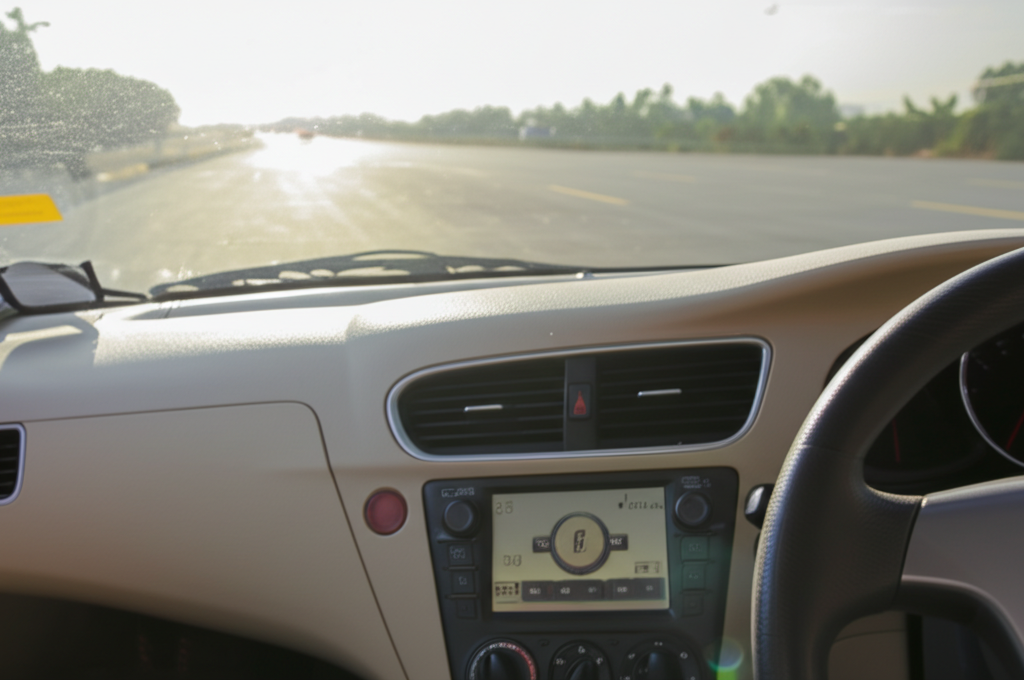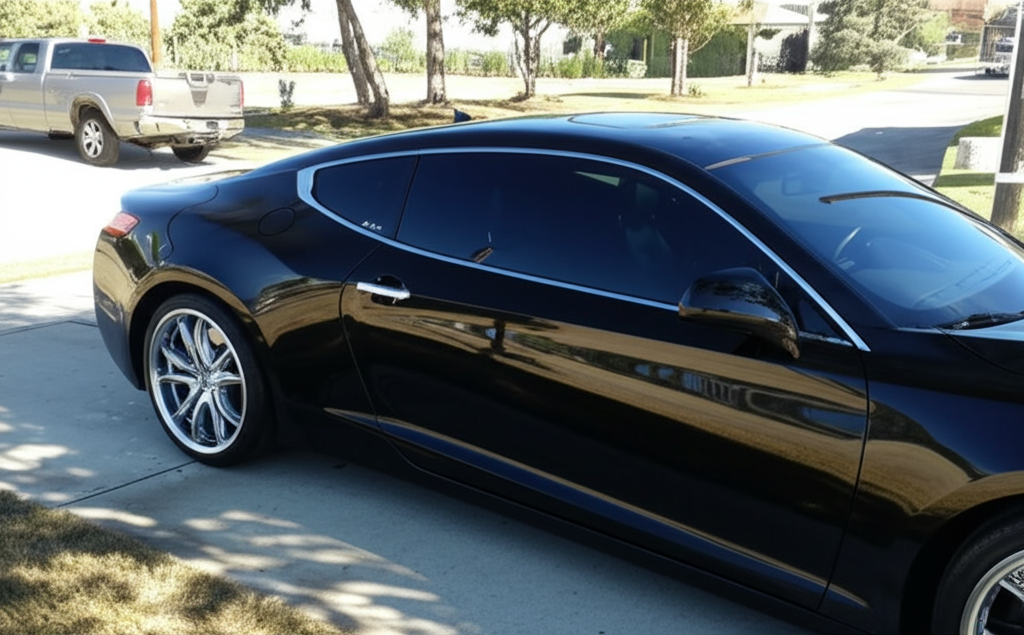Stepping into your car after it’s been parked under the relentless Thai sun… we’ve all been there. It’s like opening an oven door. The steering wheel is too hot to touch, the seats scald your legs, and the air itself feels thick and stagnant. But beyond the immediate discomfort, have you ever worried about what else that intense heat might be doing inside your car? That “new car smell” might fade, but the heat can cause plastics, adhesives, and upholstery in your car’s interior to release Volatile Organic Compounds (VOCs) – potentially harmful gases like formaldehyde and benzene. For health-conscious car owners, especially those with families, the thought of unknowingly breathing these fumes daily is a serious concern. Is there a way to combat the heat *and* make your car’s cabin a healthier space?

Khun Veerachai’s Story: From Sweltering Commutes to Cool Comfort
Meet Khun Veerachai, a marketing manager living in Bangkok. His daily commute often involved navigating heavy traffic under the scorching sun. “My black sedan looked great,” he shares, “but it became an absolute sauna after just an hour parked outside. The air conditioning struggled, and I always felt sluggish after driving. Worse, my young daughter sometimes complained about the ‘funny smell’ in the car on hot afternoons, which really worried me.” Veerachai was concerned about the long-term effects of the heat on his car’s interior – potential cracking of the dashboard, fading upholstery, and especially, the release of those unseen chemicals.
After researching solutions, Veerachai decided to invest in high-quality ceramic window film for his car. He visited a reputable installer who explained the differences between film types and helped him choose a film compliant with Thai regulations, balancing heat rejection with visibility. The installation process took just a few hours.
The difference was immediate and remarkable. “The very next day, getting into my car felt completely different,” Veerachai recalls. “It was noticeably cooler, maybe 10-15 degrees Celsius less intense. The AC cooled the cabin down much faster and didn’t have to work nearly as hard. The glare was significantly reduced too, making driving more comfortable. Most importantly, that ‘funny smell’ on hot days disappeared. I feel much better knowing the extreme heat isn’t baking the interior anymore, and my family is breathing cleaner air during our drives.” His dashboard and seats are also protected from damaging UV rays, preserving the car’s value and appearance.

Understanding Window Film: More Than Just Shade
Car window film isn’t just about aesthetics or privacy; it’s advanced technology designed to combat the specific challenges posed by sunlight. The key lies in its ability to selectively block different wavelengths of solar energy.
- Ultraviolet (UV) Rays: These are the primary cause of fading and degradation of your car’s interior surfaces (dashboard, seats, trim). Quality films block up to 99.9% of UV rays, acting like sunscreen for your car and protecting your skin during drives.
- Infrared (IR) Rays: These are the heat-carrying rays. High-performance films, particularly ceramic and advanced nano-carbon types, are engineered to reject a significant percentage of IR radiation (often measured as Total Solar Energy Rejected – TSER, or specifically Infrared Rejection – IRR). This is the magic behind keeping your car cooler.
- Visible Light: This is the light we see. Window films reduce the amount of visible light entering the car, which cuts down on glare and provides privacy. Thai regulations specify maximum tint levels (Visible Light Transmission – VLT), so choosing a compliant film is crucial.
How does reducing heat help with harmful gases? The release of VOCs from interior materials (off-gassing) is significantly accelerated by high temperatures. By keeping the interior temperature lower, quality window film directly reduces the rate at which these potentially harmful chemicals are released into the air you breathe inside the car. It creates a more stable, less reactive environment for the materials.
Let’s compare the common types of window films available:
| Feature | Dyed Film | Metallic Film | Carbon Film | Ceramic Film |
|---|---|---|---|---|
| Heat Rejection (IRR / TSER) | Low to Moderate | Moderate to High | Good to Very Good | Very Good to Excellent |
| UV Protection | Good (Can fade over time) | Excellent | Excellent | Excellent |
| Glare Reduction | Good | Very Good | Very Good | Excellent |
| Signal Interference (GPS, Phone, Radio) | None | Potential Interference | None | None |
| Appearance | Flat Black (can turn purple over time) | Reflective/Shiny | Matte Black | Non-reflective, clear view |
| Durability / Lifespan | Shorter (3-5 years) | Longer (5-10+ years) | Longer (5-10+ years) | Longest (10+ years, often lifetime warranty) |
| Price Range (Installed) | $ (Lowest) | $$ | $$$ | $$$$ (Highest) |
| Health Benefit (Reduced Off-Gassing via Heat Reduction) | Minimal | Moderate | Good | Excellent |
| Best For | Basic privacy & minimal heat reduction on a tight budget. | Good heat rejection, but potential signal issues. Cost-effective performance. | Good heat rejection, no signal issues, durable matte look. Good mid-range option. | Maximum heat rejection, clarity, longevity, and health benefits. Best overall performance. Ideal for health-conscious owners. |
For health-conscious owners specifically concerned about VOCs released by heat, Ceramic and high-end Carbon films are typically the best choices due to their superior Infrared Rejection capabilities without causing signal interference.
Peace of Mind: What Other Drivers Are Saying
The difference quality window film makes is often profound, extending beyond simple temperature readings:
Malee, Mother of two, Chiang Mai: “Before tinting, the kids would complain constantly about the heat in the back seat. Now, road trips are so much more pleasant. I also feel much better knowing the car isn’t filling up with that ‘hot plastic’ smell. It feels safer, healthier.”
Surachai, Sales Executive, Phuket: “I spend hours driving between appointments. The glare used to give me headaches by the end of the day. The ceramic film made a huge difference in comfort, and my car stays significantly cooler even parked near the beach. My fuel consumption for AC has slightly decreased too!”
Priya, University Student, Bangkok: “I was worried about my car’s interior fading quickly in the sun. The film not only protects it but makes the car feel so much more comfortable and private. Knowing it helps block UV rays for my skin is a bonus I didn’t even think much about initially!”
Ready for a Cooler, Healthier Drive?
Stop dreading getting into your car on a hot Thai day. Protect your investment, enhance your driving comfort, and most importantly, create a healthier environment for yourself and your passengers. Investing in quality window film addresses the core concern of heat buildup and its potential impact on air quality by reducing the conditions that cause interior materials to off-gas.
Take the first step towards a more comfortable and health-conscious driving experience. Contact us today to discuss your needs, learn more about the best film options for your vehicle and budget, and get a personalized quote.
📱 Want to learn more about car wrap & paint protection?
Feel free to reach us on LINE:

🌐 Official Website: https://tpuwraps.com
Frequently Asked Questions (FAQ)
- Q: Is window tinting legal in Thailand?
- A: Yes, but there are regulations. Generally, the front windscreen must allow at least 70% Visible Light Transmission (VLT), and the front side windows typically require at least 40% VLT. Rear side and rear windows often have more flexibility. Reputable installers are knowledgeable about current Thai traffic laws and will ensure your film choices are compliant.
- Q: Does window film *directly* filter out harmful gases like VOCs?
- A: Not directly like an air filter. However, high-performance window film significantly reduces the *cause* of increased off-gassing – excessive heat. By keeping the car’s interior temperature much lower, it dramatically slows down the rate at which plastics, adhesives, and textiles release VOCs. So, indirectly, it leads to cleaner cabin air on hot days.
- Q: How long does professional window film installation take?
- A: Typically, installing window film on a standard sedan takes between 2 to 4 hours, depending on the vehicle complexity and the type of film being installed. It’s usually done within a single appointment.
- Q: What kind of warranty comes with quality window film?
- A: Reputable brands, especially ceramic films, often come with long-term or even lifetime warranties against bubbling, peeling, cracking, and excessive color change. The warranty usually covers both the film material and the installation labor when done by an authorized dealer.
- Q: Will darker film provide more heat rejection?
- A: Not necessarily. Advanced film technology, like ceramic film, can offer very high heat rejection (IR blocking) even in lighter shades that comply with stricter VLT regulations. The *type* of film technology is more important for heat rejection than just the darkness (VLT) level.
Invest in Your Comfort and Well-being
In Thailand’s tropical climate, your car is constantly exposed to intense solar radiation. Choosing the right window film is more than an upgrade; it’s a proactive measure for your comfort, your vehicle’s longevity, and crucially, your health. By significantly lowering interior temperatures, you mitigate the risk associated with heat-induced VOC release, reduce reliance on air conditioning, protect your skin and eyes from harmful rays, and preserve your car’s interior.
Don’t let the heat dictate your driving experience or compromise your peace of mind. Explore the benefits of modern window film technology today and transform your car into a cooler, safer, and healthier haven on the road.